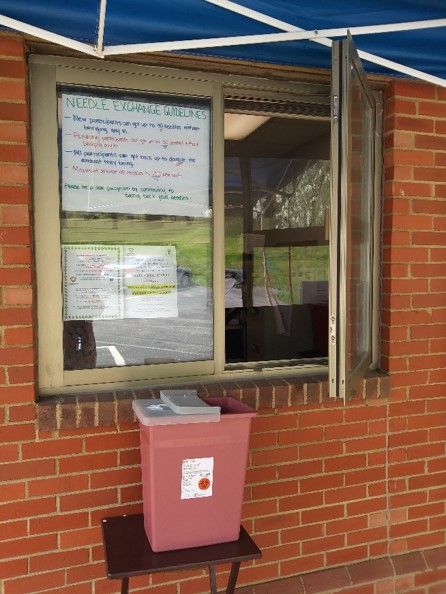Public Health Saves Lives


Hours
Monday – Friday
12:00pm – 4:00pm
Services
Anonymous & Confidential Program
What do we offer?
– Safe Disposal of used needles
– Clean Needles
– Free confidential HIV testing
– Education
Customer Satisfaction Survey

Scan QR Code or access the survey at FCHD.org/SEPFeedback
- A public health program for people who are injecting drug users (IDUs).
- On March 24, 2015, the Kentucky General Assembly gave municipalities authority to institute a needle exchange program. As a proven practice to reduce the spread of Hepatitis C, HIV and blood-borne diseases.
- Senate Bill 192 was passed to allow local health departments to give clean needles to IDUs in exchange for their used needles, with no criminal penalty for the drug users
- Proven to reduce the spread of hepatitis C, HIV and other blood-borne infections
- Provides new, sterile syringes and clean injection equipment
- Properly disposes of contaminated syringes
- Safe disposal of used needles
- Free confidential testing for HIV (optional)
- Education about the harms associated with drug use and how to minimize them
- Counseling and treatment
- NOTE: We will not accept needles from patients with diabetes. We realize the need for these patients to dispose of their used needles and have learned from the city/county that these needles can be put in the regular trash if they are sealed in a heavy plastic or metal container such as a coffee can or similar plastic container, like a laundry detergent container. We urge patients who need to dispose of needles used for insulin to do so according to accepted procedures.
Drug overdoses continue to climb at an alarming rate and remain a major cause of preventable deaths. Calling 911 during an overdose can mean the difference between life and death, but some witnesses avoid calling due of fear of arrest. In response, Kentucky has enacted KRS 218A.133, which protects people from prosecution when they report a drug overdose. This is commonly known as a “Good Samaritan Law,” and it provides an important tool to save lives. There is no longer any need to watch a friend or family member die due to a fear of criminal prosecution.
The Matthew Casey Wethington Act for Substance Abuse Intervention is named for Matthew Casey Wethington, who died in 2002 from a heroin overdose at the age of 23. Casey was an energetic young man who enjoyed life until it was “taken” by drugs. Casey never intended to become addicted to drugs when he used it the first time. What he did not realize was that his using would progress from abusing to dependence and then to the disease of addiction. Although his parents tried to get him help, there was no law that could force someone into treatment because he was an adult. After Casey’s death, his parents lobbied for a change. “Casey’s Law” is an involuntary treatment act for those who suffer from the disease of addiction.
More information can be found at: http://odcp.ky.gov/stop-overdoses/Pages/default.aspx
Naloxone (Narcan®) is a prescription medication that can reverse an overdose that is caused by an opioid drug. When administered during an overdose, naloxone blocks the opioids on the brain and restores breathing. It can be given as an injection into a muscle or as a nasal spray.
Naloxone has no potential for abuse. If it is given to a person who is not experiencing an opioid overdose, it is harmless. If naloxone is administered to a person who is experiencing an opioid overdose, it will produce withdrawal symptoms. Naloxone does not reverse overdoses that are caused by non-opioid drugs.
Naloxone should be stored at room temperature and away from light. The shelf life of naloxone is approximately two years.
- Naloxone has been approved since 1971
- Naloxone is not a controlled substance
- Naloxone is an inert medication, non-addictive
- Naloxone can be administered repeatedly without harm
- Naloxone has no potential for abuse
- Naloxone has a shelf life of two years
- Naloxone can be administered intramuscularly, intranasally via atomizer devise or via an auto-injector
Receive Narcan training for free online and a Narcan kit will be mailed to you for free. Link: FCHD.org/FreeNarcan
- Try to wake the person up by yelling their name and rubbing the middle of their chest with your knuckles (sternum rub).
- Call 9-1-1. Indicate the person has stopped breathing or is struggling to breathe.
- Make sure nothing is in the person’s mouth that could be blocking their breathing. If breathing has stopped or is very slow, begin rescue breathing.
- Tilt their head back, lift chin, pinch nose shut.
- Give 1 slow breath every 5 seconds. Blow enough air into their lungs to make their chest rise.
- Use naloxone and continue rescue breathing at one breath every 5 seconds.
- If the person begins to breathe on their own, put them on their side so they do not choke on their vomit. Continue to monitor their breathing and perform rescue breathing if respirations are below 10 breaths a minute. If vomiting occurs, manually clear their mouth and nose.
- Stay with the person until EMS arrives.

- Assessing Community Need/Engagement/Outreach
- Approval Process/Obtaining Funding
- Key Barriers/Modifications
- Success and Community Impact
- Exchange Rate Return
Assessing Community Need/Engagement/Outreach
The Franklin County Health Department opened the SEP in May 2016. Implementation practices began before approval went to the fiscal court or the city commission. The health department did not want to start the process with the mindset that the department thought it was a need, but rather that the community did. There were focus groups formed that were centered around Narcan training. The magistrates and city council members were invited to the training sessions. Information was presented about the overdose rates, as well as the Center for Disease Control map with the vulnerable counties at risk of an HIV outbreak. A template was used from the Kentucky State Department of Public health with guidelines that suggested ways to operate a SEP. The implementation process began with a collaboration between an existing MAPP coalition and other community stakeholders. Flyers and ads were created and distributed to local community partners and hung in the hospital emergency room. There was also a television commercial ran at the start of the program. Treatment centers were invited to be present at the exchange to be a resource for those who may want to seek treatment. Engagement and collaboration were key to starting the SEP in Franklin County.
The process of approval for the SEP in Franklin County took some time due to the extended process that must be followed. The Board of Health was the first step in the approval process. Once the Board of Health agreed, it went on to fiscal court. The fiscal court approved the SEP, and it was sent to the city commission. The Board of Health approved the SEP on August 17, 2015; the fiscal court approved it on October 16, 2015; the city approved it on January 25, 2016. It opened in May, this allowed for time to purchase supplies and participate in the Harm Reduction Summit training. In the beginning, there was no funding available for the implementation of the SEP. The board agreed to fund the program with local tax dollars. There was an estimated need of $60,000 a year. The first year the SEP was opened, the $60,000 was received for opening costs. The rest of the funding sources was broken down accordingly: $4,000 for the state, $4,000 in federal grants, and $40,000 from the Board of Health. The grant funds are used to pay for staff time and other needs, but not the syringes or needles. There is approximately $15,000 budgeted for salary payment.
There are quite a few grants that help fund the SEP. The state provides $10,000 in grants for HIV prevention. The SEP uses this grant because many resources can be provided through the program for HIV prevention. The grants are applied for through the local Agency for
Substance Abuse Policy (ASAP) boards because the health department is not considered a nonprofit organization. The Office of National Drug Control Policy released grants and the local ASAP boards applied for these grants to fund the SEP. This funding is used to purchase alcohol supplies, condoms, and other items. The health department will purchase these items and be reimbursed through grant funding. They must report back monthly stats (visits, testing, drugs, treatment, number of syringes) to the ASAP board. These grants played a role in the functionality of the SEP and allowed for successful implementation.
There were barriers that Franklin County had to overcome to be able to implement the SEP in their jurisdiction. The first barrier was the approval of the Board of Health. The board chair was skeptical due to the concept of permission and the idea that giving clean needles came with permission to use. To overcome this barrier, there was data presented from the CDC and the World Health Organization. They had one on one meetings and provided community education.
The next obstacle was approval from the city commission. During the first vote, two voted “no,” and the third voted to abstain because they wanted more information. Active community members played a significant role in impacting city commission. It ended up passing in city commission by one vote. The only caveat was that there was a requirement for an update every six months and that the program could be taken away at any time. The Public Health Director provided updates twice and after that was not asked to come back again due to success in the implementation phase.
Due to the increasing numbers and 80% return rate, there are still staffing and funding barriers. Every staff member is trained in needle exchange and interns are also utilized to fulfil this need. Grants will not allow for syringes to be purchased with federal money, so the funding must come from other sources. Careful planning of resources comes into play to overcome these challenges. Modifications have been made in terms of the delivery model. There is a cap of 100 needles, which can get them through the week and is enough to give to other people that may need them. The first visit is needs based and it is ideal for participants to return once a week.
There was a bill introduced that could make the delivery model one for one across the board. Due to this, they have been stricter on giving a lower number of needles if participants do not bring back needles. They found that participants are more likely to bring the needles back if they are provided with a sharps container. This container has a card with the information of the health department. If the participant were to get arrested, it would be thrown out as long as there are not drugs present. The hours of operation have expanded since the SEP was first opened. It is now open every day of the week, which allows for the services to be more utilized. There have been some complaints from participants that use other services due to being in the same waiting room as injection drug users. They try to combat this with education of the SEP and the positives of
having one in the county.
Some modifications were made since the program first opened in 2016. When first opened, services were only offered on Fridays. The location was right next to the Sheriff’s Department. These two factors could have contributed to a slow start. The next step was opening a service at another building while utilizing a mobile command center. After this change, there was an increase in numbers and allowed for more accessible public transportation access. The SEP has its own waiting room and area to see participants in the Public Health Department. This change increased participation and use of services.
The SEP is considered a success in Franklin County. For the 2018-2019 year, there were 456 initial visits and 845 subsequent visits. SEP staff made 16 referrals to treatment at the initial visit and 16 referrals at a subsequent visit. There were 85, 330 syringes provided and 67, 380 syringes collected with a 79% return rate. Additionally, there was significant support from community partners and key stakeholders in the local community. The participation rates have continued to increase due to successful outreach practices. There were many moving parts and community partnerships formed to allow for successful implementation. There is a community needs assessment conducted every five years. In 2013, drug use was the number one concern in the community. The hope is by the next cycle this concern will move down due to the resources that are in place for community members to utilize. This needs assessment allows the health department to address needs within the community and develop future goals to work toward. The SEP in Franklin County has continued to grow due to the respect factor that is incorporated into their daily practice. They also are open every day of the week, which allows for flexibility for participants.
| Exchange Rate | 2022-2023 | 2021-2022 | 2020-2021 | 2019-2020 | 2018-2019 | 2017-2018 | 2016-2017 | 2015-2016 |
| Syringes Provided | 109,114 | 163,837 | 233,618 | 176,250 | 165,339 | 119,061 | 32,475 | 434 |
| Syringes Collected | 84,508 | 147,638 | 196,518 | 124,769 | 125,200 | 89,480 | 21,463 | 387 |
| Return Rate | 77% | 90% | 84% | 71% | 76% | 75% | 66% | 89% |
The year runs July 1 – June 30th
Updated: March 1, 2024
